优秀英语评课稿之欧阳歌谷创编
- 格式:doc
- 大小:54.01 KB
- 文档页数:19
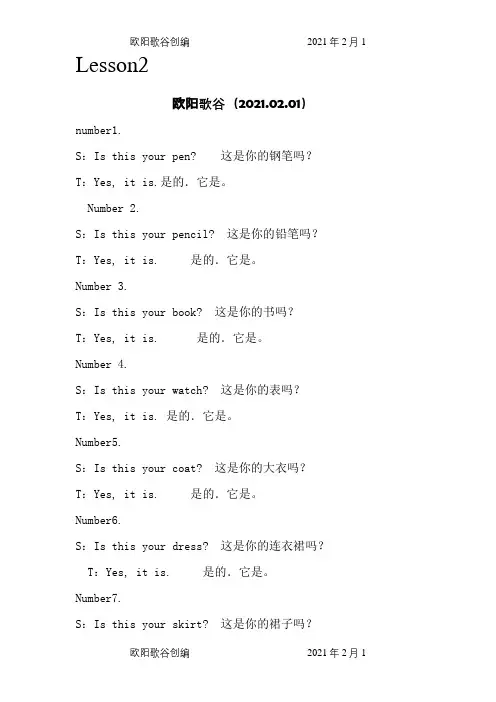
Lesson2欧阳歌谷(2021.02.01)number1.S:Is this your pen? 这是你的钢笔吗?T:Yes, it is.是的.它是。
Number 2.S:Is this your pencil? 这是你的铅笔吗?T:Yes, it is. 是的.它是。
Number 3.S:Is this your book? 这是你的书吗?T:Yes, it is. 是的.它是。
Number 4.S:Is this your watch? 这是你的表吗?T:Yes, it is. 是的.它是。
Number5.S:Is this your coat? 这是你的大衣吗?T:Yes, it is. 是的.它是。
Number6.S:Is this your dress? 这是你的连衣裙吗?T:Yes, it is. 是的.它是。
Number7.S:Is this your skirt? 这是你的裙子吗?T:Yes, it is. 是的.它是。
Number 8.S:Is this your shirt? 这是你的衬衣吗?T:Yes, it is. 是的.它是。
Number 9.S:Is this your car? 这是你的汽车吗?T:Yes, It is. 是的.它是。
Number 10.S:Is this your house? 这是你的房子吗?T:Yes, it is. 是的.它是。
Lesson4number1.Is this your pen? 这是你的钢笔吗?S:Yes, it is. 是的.Number 2.Is this your pencil? 这是你的铅笔吗?S:Yes, it is. 是的.它是。
Number 3.Is this your book? 这是你的书吗?S:Yes, it is. 是的.它是。
Number4.Is this your watch? 这是你的手表吗?S:Yes, it is. 是的.它是。
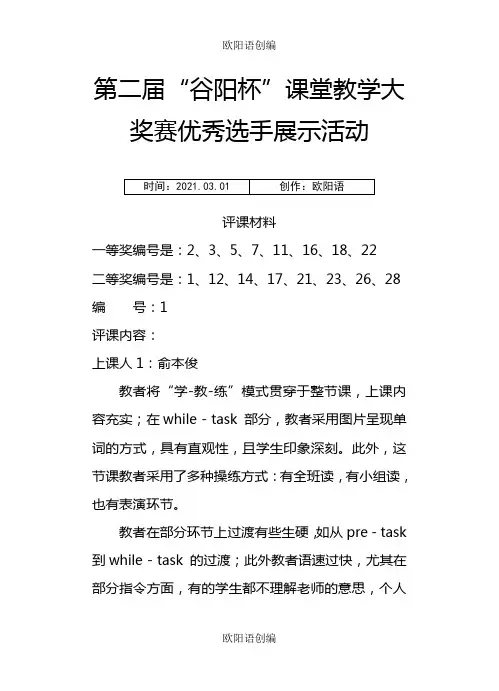
第二届“谷阳杯”课堂教学大奖赛优秀选手展示活动评课材料一等奖编号是:2、3、5、7、11、16、18、22二等奖编号是:1、12、14、17、21、23、26、28编号:1评课内容:上课人1:俞本俊教者将“学-教-练”模式贯穿于整节课,上课内容充实;在while - task 部分,教者采用图片呈现单词的方式,具有直观性,且学生印象深刻。
此外,这节课教者采用了多种操练方式:有全班读,有小组读,也有表演环节。
教者在部分环节上过渡有些生硬,如从pre - task 到while - task 的过渡;此外教者语速过快,尤其在部分指令方面,有的学生都不理解老师的意思,个人建议如果有些指令太难,可适当用中文提示。
上课人2:代娣本节课教者教学思路清晰,课件制作十分精美,极具实用性,从这点可看出教者工作态度认真,值得我学习。
整节课课堂气氛十分活跃,教者成功做到了让学生快乐中收获知识。
此外,教者还打破常规,comic strips 部分在熟读的情况下未让学生去表演;另外,单词巩固环节教者设计的游戏将这节课的氛围推向了高潮,相信学生对这些单词也印象深刻。
教者在刚开始上课时就对学生要求每回答对一个问题就可以获得一棵树,但在上课过程中教者未能从始至终提及这点。
上课人3:周蓓蕾教者声音甜美,教态自然,能在课堂上做到收放自如,这点值得我学习。
此外教者为本节课做了精心准备:如为了能让学生更好地理解自然灾害,教者准备了多个视频,并且为避免重复,教者也充分利用图片导入单词;对于不同阶段的教学任务,教者精心设计了不同的教学活动。
虽然视频为本节课添色不少,但有的视频内容太难,有无字幕,学生理解上有点困难。
另外我不是很赞成教者用录音代替视频做法。
上课人4:张娟整节课教者把“小星星得分”这一环节贯穿始终。
此方法不仅仅很好地体现了小组学习这一教学思想,还极大调动了学生的积极性,课堂气氛活跃。
对于不同的教学任务,教者设计了不同的教学环节:如用抢答的方法来巩固单词,这个活动把课堂氛围推向了高潮;还有对过去进行时的训练教者采用了对话的方式,避免了以往的语法讲解法。
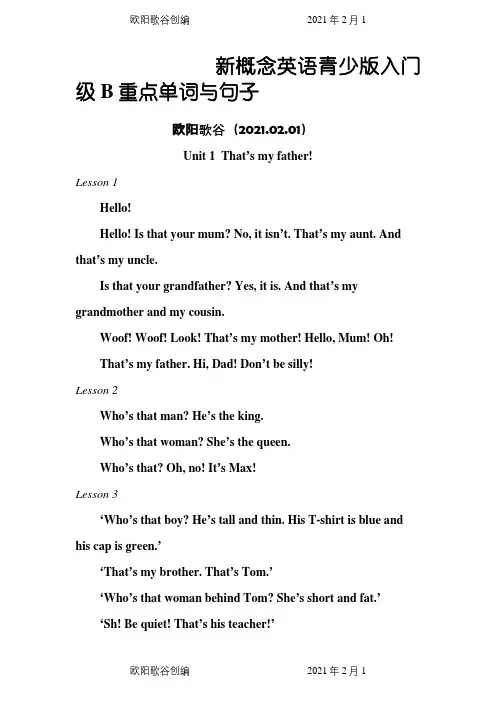
新概念英语青少版入门级B重点单词与句子欧阳歌谷(2021.02.01)Unit 1 That’s my father!Lesson 1Hello!Hello! Is that your mum? No, it isn’t. That’s my aunt. And that’s my uncle.Is that your grandfather? Yes, it is. And that’s my grandmother and my cousin.Woof! Woof! Look! That’s my mother! Hello, Mum! Oh!That’s my father. Hi, Dad! Don’t be silly!Lesson 2Who’s that man? He’s the king.Who’s that woman? She’s the queen.Who’s that? Oh, no! It’s Max!Lesson 3‘Who’s that boy? He’s tall and thin. His T-shirt is blue and his cap is green.’‘That’s my brother. That’s Tom.’‘Who’s that woman behind Tom? She’s short and fat.’‘Sh! Be quiet! That’s his teacher!’Unit 2 This is our house.Lesson 1This is our house .Welcome! Thanks!Is this your kitchen? Yes, it is. Lucky dog!This is our sitting room. Very nice!Is that their bedroom? Yes, That’s their bedroom.This is fun! This isn’t fun!Lesson 2Where’s Pop? He’s in our house. He’s in the dining room.Our sitting room is next to the dining room. And our dining room is between the kitchen and the bedroom. Very nice! But where’s your bathroom?Lesson 3My name’s Mike. That’s my sister, Emma, in front of our house.In our house ,the kitchen is next to the dining room.The sitting room is between a bid bedroom and a little bedroom.Look at my mum and dad! They ‘re in their bedroom!Their bedroom is big and yellow.My bedroom is little and blue.Unit 3 Get off the bed.Lesson 1There’s a big bed in my bedroom. There’s a lamp next to the bed. Kim! Get off the bed!There’s a desk and a chair in my room. Oh! There’s a computer. There isn’t a computer in our bedroom.Look! There’s a poster. It’s a panda. And there’s a doll on the shelf.Kim! Get off the bed! Oh! Ha! Ha!Lesson 2Is there a door? No, there isn’t.Is there a window in this house? No, there isn’t.Yes, there is! Look at the wall!Lesson 3That’s my bedroom! My bed is big. It’s between the door and the window. There’s a little table next to my bed. There isn’t a desk. There’s a shelf behind the table. There’s a lamp on the shelf. Look at my frog! It isn’t on my bed! It’s under the chair.Unit 4 It’s time for lunch.Lesson 1Good morning, Dan! It’s eight o’clock. Oh! It’s morning. It’s time for breakfast!It’s one o’clock. It’s time for lunch! Very nice! A bone!It’s six o’clock. It’s time for supper. Yummy!It’s ten o’clock. It’s time for bed. Good night, Dan! Goodnight! A great day! Thanks, Robert!Lesson 2What time is it? It’s eleven o’clock. It’s time for breakfast.What time is it? It’s twelve o’clock. It’s time for lunch.Pop! It’s night!Lesson 3“Mum, where are you?’‘I’m in the kitchen.’‘What time is it, Mum?’‘It’s one o’clock. It’s time or lunch!’‘What for lunch, Mum?’‘A chop and salad. Sam, here youare!’‘Yummy! And an apple?’‘Yes, an apple!’‘Thanks, Mum!’Unit 5 That’s Ted’s puppet.Lesson 1Look at this bedroom! What a mess! Look! That’s Ted’s puppet. Yes! And this is Anna’s skipping rope.This isn’t Ted’s skateboard. No, that’s Robert’s skateboard. And this is my game.This is Ted’s spaceship. This is his boat. Is this Anna’s puzzle? Oh, dear!What’s this? It’s Kim’s bone. Oh! There it is! Hurray!Lesson 2Whose Frisbee is it? It’s Pop’s. It’s Max’s.Whose football is it? It’s Pop’s. It’s Max’s. OK! Thank youfor this Frisbee and football.Lesson 3My name is Mark. My favourite toy is a spaceship. My sister’s name is Joan. What’s her favourite toy? No, it isn’t a doll. It’s a puppet. The Puppet’s name is Pip. It’s a clown. My brother’s name is Tommy. His favourite toy is a boat. There’s a big toy in our sitting room. Whose toy is it? It isn’t my mum’s. It’s my mum’s. It’s my dad’s. It’s a computer!Unit 6 This is my uncle’s farm.Lesson 1This is my uncle’s farm. It’s great! Look! These are chickens. These are goats.Look at the birds! Those are ducks.These are little horses. These aren’t horses. These are donkeys.Those are sheep. Those aren’t sheep. Those are lambs. Lesson 2Are these cows? Yes, they are.Are those cows? No, they aren’t.They’re bulls! Help!Lesson 3This is our farm. It’s a big farm. Look there! Those are our sheep. Those are cows next to the sheep. And those are bulls in front of the cows.The bulls are big. Look here! These are our goats. And theseare our ducks.Look at their eggs! Their eggs are good for breakfast!Unit 7 What super food!Lesson 1Here you are, Mum! The boxes! What are these? They’re dishes. And glasses.Oh! What great food! What are these? They’re knives and forks.Wow! Sausages! These are strawberries. And cherries. And tomatoes. Oh, sandwiches!But where are the sausages?Lesson 2What are those? They’re potatoes. Yummy!What are those? They’re peaches. Yummy!Potatoes! Peaches! Yuk! What strange food! Yummy! Bamboo!Lesson 3Who’s that behind the table? It’s Jed. It’s his birthday. He’s nine. The food on the table is for Jed and his friends. What are those in the blue dish? They’re strawberries, cherries and peaches! And those are sausages! Sausages are Jed’s favourite food! And what’s that in front of Jed? It’s his birthday cake. Happy birthday, Jed!Unit 8 They’re Dad’s shoes!Lesson 1They’re Flora’s jeans and Ted’s trousers. They’re Mum’s skirts. They’re Anna’s dresses and Dad’s jackets. Wow! What a lot of socks!What fun! They’re Dad’s shoes!Lesson 2Whose coats are they? They’re our coats. Don’t touch!Whose scarves are they? They are our scarves. Don’t touch! Oh!Lesson 3‘What a lot of shoes and socks! Whose are they?’‘The blue shoes are my mum’s and the green shoes are my dad’s. The red and yellow shoes are my sister’s. My shoes are blue and green. The socks are my sister’s.’‘Whose jeans are they?’‘They’re my jeans and my sister’s. The trousers are my dad’s and these are my mum’s skirts.’Unit 9 They’re happy dogs.Lesson 1Stop, Dan! Kim! Come back! That’s my ball. It’s my ball.Oh, Dad! Kim! You’re dirty! We aren’t dirty! We aren’t clean!Look! They aren’t happy dogs. No! We’re unhappy and wet.We’re dry. But we’re hungry and thirsty.They’re happy dogs. Yes!Lesson 2Look! The sun! Are you cold? No, we aren’t.Are you hot? Yes, we are. But our coats and scarves are new!Peg’s skirt is old. Yes, but we’re hot and Peg isn’t.Lesson 3This is Sally and Ken. They’re cousins. These are their horses. They’re big and tall horses.Their horses are hungry and thirsty. Sally’s horse is dirty. Oops!Sally is wet and cold. Who’s that? It’s Sally’s mum. What are those in the dishes? They’re sandwiches and apples. The sandwiches are for Sally and Ken. The apples are for the horses!Unit 10 What pretty flowers!Lesson 1Look, Robert! This is the countryside. That’s our town. There are shops and houses in the countryside. And there are farms.There are tall trees next to the river. Yes! What pretty flowers!Look! There are sheep on the hills. And there are cows in the fields. And there are rabbits!Come back, Dan! There aren’t rabbits in the river, Dan. Lesson 2Are there shops in your town? Yes, there are. Look!Are there buses? No, there aren’tNo buses? No! There aren’t roods in our town.Lesson 3My aunt’s house is in the countryside. It’s a little house with a yellow door and blue windows. There are trees and flowers infront of the house. There are fields and hills behind the house. There aren’t houses next to my aunt’s house and there aren’t shops. But there are roads from the countryside to the town and there are shops in the town.Unit 11 Nineteen bones in the house!Lesson 1There are bones under the bed. Kim!There are bones next to the window. Kim!There are bones on this table. How many?There are bones behind the door. Oh, dear! They’re my bones!How many bones are there?…thirteen, fourteen, fifteen. Sixteen, seventeen, eighteen, nineteen!Kim! There are nineteen bones in the house. You’re a bad dog! Nineteen bones! Bad dog! Lucky dog!Lesson 2Ten and ten is twenty. Ten and eleven is nineteen.You’re wrong, Pop! Ten and eleven is twenty-one. Look, Pop!There are ten strawberries, ten apples and one peach. How many? One, two, three…eighteen, nineteen! Oh! You’re right!Lesson 3It is nine o’clock. Jack is at school. How many girls and boys are there? There are nineteen boys and girls. There are ten girls and nine boys. That’s Jack’s teacher in front of the door. He’s great! There are pencils, pens, rulers and books on the desks. Jack’s green school bag is next to his chair. Jack is happy at school!Unit 12 Hide behind the bush!Lesson 1Stand up, Dan! Good boy! Eat your biscuit!Sit down, Dan! Good boy! Eat your biscuit!Dan is a good dog. Yes. Biscuits are for good dogs.Jump! Drink your water! Look at the biscuits!Catch! Run! Hide behind the bush! This is fun! Biscuits are for bad dogs!Lesson 2Hello! Peg! Please don’t shout! Be quiet!Good morning! It’s a great morning! Please don’t sing that song!It’s time to get up! Peg! Don’t throw that water!Lesson 3‘Look! It’s the teacher. Stand up!’‘Good morning, boys andgirls! Please sit down! Andy! Don’t eat in class! Please read! Very good, Andy! Jenny! Spell “white”. You’re right, Jenny! But please don’t shout! Mark, don’t write on your desk! Where’s your book, Joe? Don’t throw your book, Joe! Helen! Sit on your chair and don’t drink in class! Now, boys and girls, it’s time for lunch! Don’t run!’Unit 13 I can dance!Lesson 1I can draw cars. I can write. I can’t draw. I can’t write.Robert! I can read. Listen! Clever boy! Look, Flora! I can dance! Well done! I can’t read. I can’t dance.Look! I can play football. Look! I can play tennis. I can’t play football. I can’t play tennis.I can play the violin. I can play piano. I can’t listen!Lesson 2Can you touch your toes? Yes, I can. No, I can’t.Can you stand on your hands? Yes, I can. No, I can’t.Peg! Peg! Can you stand up?Lesson 3My name is May and I’m nine. I’m in class 5 at scho ol. I can read and write English. There is football and tennis at our school.I can play tennis. I can’t play football. Our teacher is a man. He’s tall and thin. He’s nice. I’m a good dancer but I can’t dance hip-hop! I can play the piano and I can sing a lot of songs.Unit 14 They’re amazing!Lesson 1They’re amazing! They can stand on their hands. Look at the girl’s blue dress! The girl’s horse is big!Robert! Anne! Ted! Sandwich? No, thanks. I’m not hungry. Anna! Look! No thanks. We aren’t hungry.I’m Tim! He’s Tom! Hello! Tom is fat! And his shoes are big. Run, Tom!Where’s Tom? He’s under the box! Sh! Anna! Don’t shout!He isn’t under the box. Ha! Ha! You’re wet, Tim!Lesson 2Who’s that? That’s my cousin, Pam.This is Peg and Max. Hello! Are you Pop’s friends? Yes, we are.Are peg and Max brother and sister? No, they aren’t. Peg is a pig. Max is a monkey. Oh! Are they cousins?Lesson 3I’m Simon. I’m at the zoo with my sister and my mum and dad. We’re happy. The zoo is great!Look behind my sister! There’s a monkey. Its arms and legs are long. Where is it? It’s in the tree with its friends.Look! A horse! Oh, it isn’t a horse. It’s a zebra. Oh! Look atthe pandas! What a lot of bamboo! They’re hungry. My sister and I are thirsty! Oh, thanks, Mum! Water!Unit 15 Let’s play football!Lesson 1Whose bedroom is it? It’s Robert’s.Is that a ball? No, it isn’t. There isn’t a ball. Oh! Help!What’s this? Oh! It’s a kite! What are these? These are books and games. Oh, there’s a ball.Let’s play football! OK! Catch the ball!Oops! What are those? They’re shoes.This is fun. Whose shoes are they? They’re Robert’s. Oh! Hello, Robert!Lesson 2Look! There are strawberries peaches and apples in the fields. Read that, Peg! I can’t read.How many peaches can you eat, Peg? Twenty! Throw hose apples, Max!Stop! It’s Farmer Green! Run, Peg!Lesson 3My name is Eva. There are seven rooms in my house. There are here bedrooms, a sitting room, a dining room, a bathroom and a kitchen.My bedroom is next to my brother’s bedroom. It isn’t a bigroom but it’s pretty. The walls in my bedroom are yellow and there are a blue chair and a blue desk. There’s a poster on the wall. There are green fields with red flowers on the poster. It’s my favourite poster!。
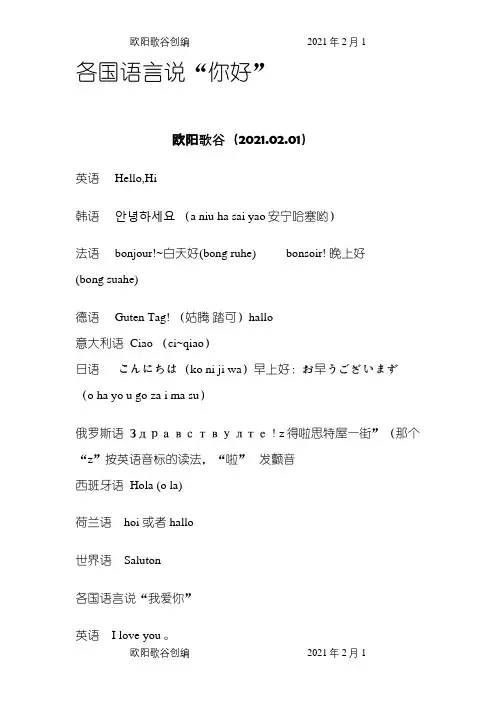
各国语言说“你好”欧阳歌谷(2021.02.01)英语 Hello,Hi韩语안녕하세요(a niu ha sai yao安宁哈塞哟)法语 bonjour!~白天好(bong ruhe) bonsoir! 晚上好(bong suahe)德语 Guten Tag! (姑腾踏可)hallo意大利语 Ciao (ci~qiao)日语こんにちは(ko ni ji wa)早上好:お早うございまず(o ha yo u go za i ma su)俄罗斯语Здравствулте! z得啦思特屋一街”(那个“z”按英语音标的读法,“啦”发颤音西班牙语 Hola (o la)荷兰语 hoi 或者 hallo世界语 Saluton各国语言说“我爱你”英语 I love you 。
法语 Je t'aime. Je t'adore.(我喜欢你)(也带嘛)德语 Ich liebe dich.(yi xi libe di xi)韩语사랑해 (3朗嗨哟)日本愛いしてる (a yi xi da lu)西班牙 Te amo (得阿摸)葡萄牙 Eu amo-te. (哎呜啊木腿)希腊语 S 'agapo (sa ha po)丹麦 Jeg elsker dig (接个爱死替个)芬兰 Minarakastan sinua (明那拉卡司谈洗奴娃)捷克 Miluji te (米卢急特)缅甸 Chit pa de (起拍得)菲律宾 Mahal kita (马哈吉他)犹太语 Ani Ohev otach (啊你偶和夫偶踏西)世界语 Mi amas vin各国语言说“谢谢”英语: Thank you菲律宾语:Salamat Do(撒拉玛特朵)日语:あリがとゥ(阿里嘎都)其实后面还应该有后缀,但是日语的敬词比较麻烦,还有男女之分,就不多说了啊~~~韩语:감사합니다(勘三哈咪瘩)马来语: terima Kasih(得力马卡系)越南语: Cám o*n(嘉蒙)泰语: kob-khun(寇布库恩)印度语: dhanyavaad(达尼阿瓦德)希伯来语:toda(透达)土耳其语:te?ekkür ederim(特谢库尔埃戴里姆)波兰语: Dzie,kuje(以库以而)俄语: Spasibo(思巴喜柏)德语: Danke(但可)阿拉伯语:shokran(休克朗)巴西语: Obrigada(欧布哩嘎搭)荷兰语: dank u(当Q)法语: Merci(梅呵西)西班牙语:Gracias(格拉喜亚思)意大利语:Grazie(格啦姬)。
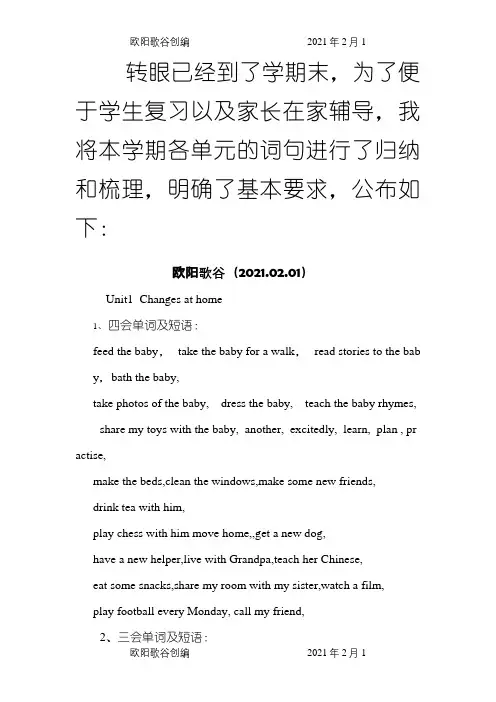
转眼已经到了学期末,为了便于学生复习以及家长在家辅导,我将本学期各单元的词句进行了归纳和梳理,明确了基本要求,公布如下:欧阳歌谷(2021.02.01)Unit1 Changes at home1、四会单词及短语:feed the baby, take the baby for a walk, read stories to the bab y,bath the baby,take photos of the baby, dress the baby, teach the baby rhymes, share my toys with the baby, another, excitedly, learn, plan , pr actise,make the beds,clean the windows,make some new friends,drink tea with him,play chess with him move home,,get a new dog,have a new helper,live with Grandpa,teach her Chinese,eat some snacks,share my room with my sister,watch a film,play football every Monday, call my friend,2、三会单词及短语:take care of him, write a letter, send email to my friends,read a book, give her a bunch of flowers , take a taxi, wash her hair,bath , cot, e-mail, move , rhyme , share, teach3、四会句型:I am going to have a new brother or sister.What are you going to do? We are going to…What is Bill going to do? He is going to…What is she / he going to do? She is going to…What are Lucy and Linda going to do?What are they going to do? They are going to…Unit 2 Turning over a new leaf1、四会单词及短:win the swimming competition,keep fit,learn Japanese,get high marks,put on weigh,improve my English ,make more friends,draw well, play more sport,practise swimming harder,take a Japanese course,work hard,eat more,read more English books,join the Cubs, join the Art Clu b,2、三会单词及短语:sick,tired,fat, leave,get , birthday ,pass the exam,work harder,lose weight,eat less,join some activity , stop eating snacks,give her a present,go to bed early,see the doctor,get off the bus one stop early,walk home,prepare my lessons, take part,pay attention,look up,find out the meaning,3、四会句型:What are you going to do?I want to…so I’m going to …You want to…so you are going to …They want to… so they are going to …。
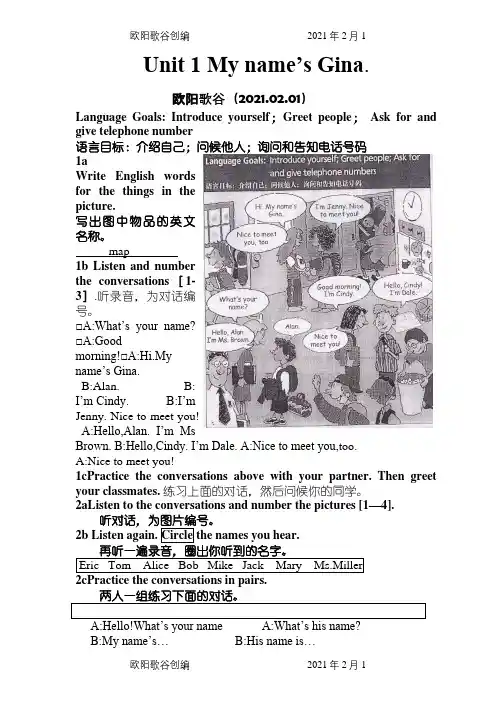
Unit 1 My name’s Gina.欧阳歌谷(2021.02.01)Language Goals: Introduce yourself;Greet people;Ask for and give telephone number语言目标:介绍自己;问候他人;询问和告知电话号码1aWrite English wordsfor the things in thepicture.写出图中物品的英文名称。
_____map________1b Listen and numberthe conversations[1-3].听录音,为对话编号。
□A:What’s your name?□A:Goodmorning!□A:Hi.Myname’s Gina.B:Alan. B:I’m Cindy. B:I’mJenny. Nice to meet you!A:Hello,Alan. I’m MsBrown. B:Hello,Cindy. I’m Dale. A:Nice to meet you,too.A:Nice to meet you!1cPractice the conversations above with your partner. Then greet your classmates.练习上面的对话,然后问候你的同学。
2aListen to the conversations and number the pictures [1—4].2b Listen again. Circle the names you hear.Eric Tom Alice Bob Mike Jack Mary lerB:My name’s… B:His name is…A:I’m…A:And what’s her name?B:Nice to meet you! B:Her name is…2d Role play the conversation. 分角色表演对话Linda:Good afternoon! My name’sLinda.Are you Helen?Helen:Yes,I am. Nice to meetyou,Linda.Linda:Nice to meet you,too.What’shername?Hele n:She’s Jane.Linda:Is he Jack?Helen:No,he isn’t.His name’s Mike.What’s your name?Alan. /I’m Alan./My name’s Alan.What’s his name?He’s Eric./ His name’s Eric.What’s her name?She’s Mary. / Her name’s Mary.Is he Jack? Yes, he is. / No, he isn’t. His name’sMike.Are you Helen? Yes, I am. / No, I’m not. I’m Gina.what’s = what is name’s = name is I’m = I amhe’s = he is she’s = she is调整词序,组成对话并练习。
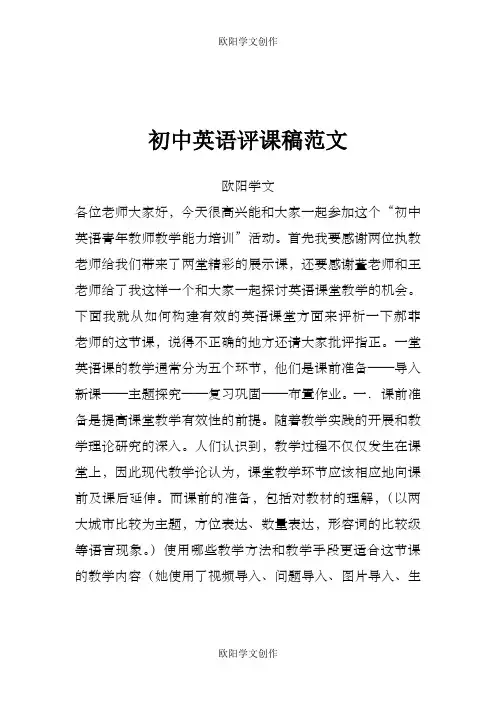
初中英语评课稿范文欧阳学文各位老师大家好,今天很高兴能和大家一起参加这个“初中英语青年教师教学能力培训”活动。
首先我要感谢两位执教老师给我们带来了两堂精彩的展示课,还要感谢董老师和王老师给了我这样一个和大家一起探讨英语课堂教学的机会。
下面我就从如何构建有效的英语课堂方面来评析一下郝菲老师的这节课,说得不正确的地方还请大家批评指正。
一堂英语课的教学通常分为五个环节,他们是课前准备——导入新课——主题探究——复习巩固——布置作业。
一.课前准备是提高课堂教学有效性的前提。
随着教学实践的开展和教学理论研究的深入。
人们认识到,教学过程不仅仅发生在课堂上,因此现代教学论认为,课堂教学环节应该相应地向课前及课后延伸。
而课前的准备,包括对教材的理解,(以两大城市比较为主题,方位表达、数量表达,形容词的比较级等语言现象。
)使用哪些教学方法和教学手段更适合这节课的教学内容(她使用了视频导入、问题导入、图片导入、生活导入),什么形式更符合这一年龄段学生的生理和心理特点(多媒体演示,小组活动、游戏操练、模仿表演),寻找和挖掘哪些有用的课程资源(介绍上海的视频、桐乡本土图片、贴近学生生活的照片、综艺节目中的砸金蛋游戏形式)等等。
大家有目共睹,为提高这堂课的教学有效性郝老师课前做了大量的准备。
二、新课导入是提高课堂教学有效性的基础。
俗话说:良好的开端是成功的一半。
一节课课题的导入与该课的教学效果有着密切的联系。
在教学中,新课的导入是很重要的一个环节,本堂课郝老师利用了1.视频导入法。
七年级学生活泼好动,且善于接受新事物。
因此,为了激发学生对英语课堂内容的兴趣和拓展课堂信息的容量,老师利用了视频具有集图形、声音、动作为一体的特点,播放了一段关于上海的视频,这一导入是根据既定的教学目标来精心设计的,没有游离于教学内容之外。
上海是一座大都市,离我们一些学生的实际生活较为遥远,学生缺乏对这方面的感性认识。
于是郝老师根据对学生的预想和对教学的需求对教材进行了解读,重构和再加工、再创造。
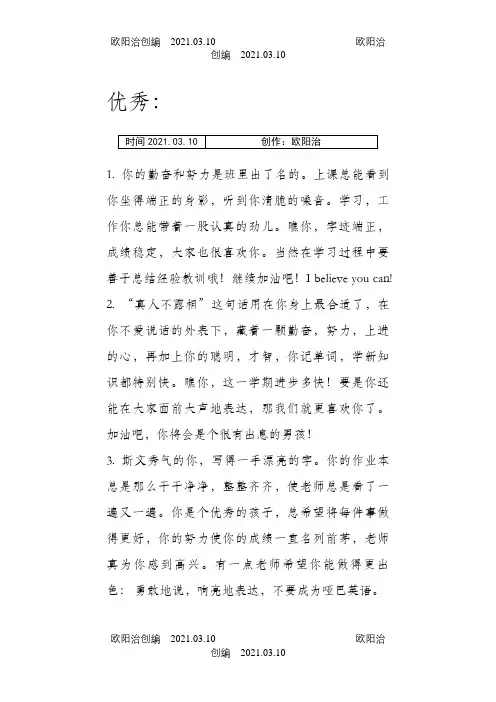
优秀:1. 你的勤奋和努力是班里出了名的。
上课总能看到你坐得端正的身影,听到你清脆的嗓音。
学习,工作你总能带着一股认真的劲儿。
瞧你,字迹端正,成绩稳定,大家也很喜欢你。
当然在学习过程中要善于总结经验教训哦!继续加油吧!I believe you can!2. “真人不露相”这句话用在你身上最合适了,在你不爱说话的外表下,藏着一颗勤奋,努力,上进的心,再加上你的聪明,才智,你记单词,学新知识都特别快。
瞧你,这一学期进步多快!要是你还能在大家面前大声地表达,那我们就更喜欢你了。
加油吧,你将会是个很有出息的男孩!3. 斯文秀气的你,写得一手漂亮的字。
你的作业本总是那么干干净净,整整齐齐,使老师总是看了一遍又一遍。
你是个优秀的孩子,总希望将每件事做得更好,你的努力使你的成绩一直名列前茅,老师真为你感到高兴。
有一点老师希望你能做得更出色:勇敢地说,响亮地表达,不要成为哑巴英语。
4. 你是个聪明、活泼而且非常可爱的小女孩。
兴趣广泛、知识全面、思维敏捷,特别使老师高兴的是,你的词汇量是多么丰富,你的回答是那么与众不同,简直棒极了。
老师相信,只要你坚持努力,会取得更大的收获,相信你能将英语讲得和说中文一样棒。
5. 你是我们班的小才女,小小年纪就已经考完了剑桥三级,金章,银章,还有小学英语一级考。
这要归功于你的努力与好学。
老师送你一句话:山外有山,楼外有楼。
不要自满,不要停留。
6. 你是一个自觉的孩子,你知道吗,当你来问老师问题时,当你让老师批改你自己给自己默写的单词时,老师是多么高兴啊。
你知道学习是为自己学的,你的努力也换来了一个个好成绩,老师相信:总有一天,你会成功的。
7. 你是个优秀的孩子。
无论是学习,还是工作,你总能带着一股认真的劲儿。
瞧你,字迹端正,成绩稳定,大家也喜欢你。
继续加油吧,你还会取得更大的进步。
8. 你的学习态度让人钦佩,每次打开你的作业本,就有一种美的享受。
尽管你不多言语,但你上课能认真听讲,工作能一丝不苟地完成,老师还是很喜欢你。
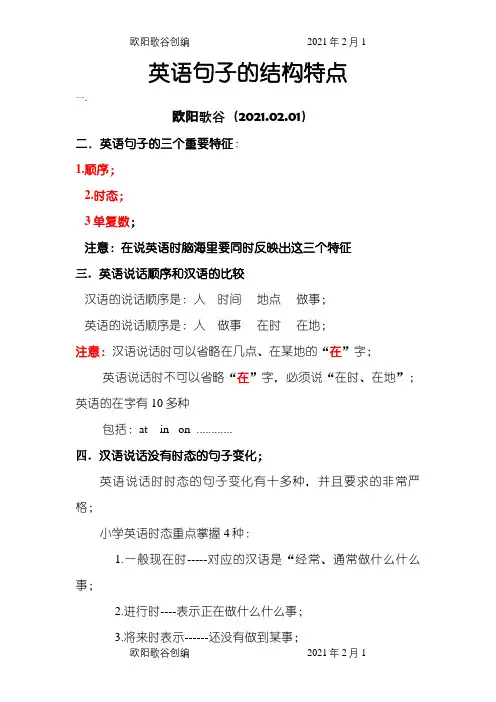
英语句子的结构特点一.欧阳歌谷(2021.02.01)二.英语句子的三个重要特征:1.顺序;2.时态;3单复数;注意:在说英语时脑海里要同时反映出这三个特征三.英语说话顺序和汉语的比较汉语的说话顺序是:人时间地点做事;英语的说话顺序是:人做事在时在地;注意:汉语说话时可以省略在几点、在某地的“在”字;英语说话时不可以省略“在”字,必须说“在时、在地”;英语的在字有10多种包括:at in on ............四.汉语说话没有时态的句子变化;英语说话时时态的句子变化有十多种,并且要求的非常严格;小学英语时态重点掌握4种:1.一般现在时-----对应的汉语是“经常、通常做什么什么事;2.进行时----表示正在做什么什么事;3.将来时表示------还没有做到某事;4.过去时-------强调的是以前做到某事;五.汉语说话时句子没有单复数的变化;英语说话时句子必须要有动词和名词的单复数变化,动词加s表示单数;如:汉语说:他每天6点在家起床;英语说:他每天起床s在6时在家;结构第一讲:人称代词“你、我、他”一.人称代词有5种:1.主格;2.宾格3.形容词性物主代词4.名词性物主代词5.反身代词二.人称代词汉语与英语的区别汉语的人称代词不论在句子的什么位置都不变英语的人称代词在句子中的不同位置有不同的词形;学英语一定要注意3个问题:1.英语句子中代词的应用都有哪些位置?2.这些位置和汉语对代词的不同在哪里?3.句子中每个位置对应的是什么词形?三.必须明确句子的成分1.主语:句子中的第一个名词或代词2.谓语:句子中的第一个动词;3.宾语:紧跟谓语的名词或代词,宾语是动作的承受对象;4.定语:修饰名词或代词的词5.状语:归类-----时间、地点、方式、原因等构成-----介词 + 名词例.he goes to schol with me他去学校(以我伴随的关系)我带他到你们班主语谓语宾语状语主格宾格物主代词我想吃肉动词1 动词2主语谓语(有时态和复数的变化)动词2不是谓语就没有时态和单复数的变化;但是还要记住英语句子中所有的动词都有变化,怎么变以后讲;主格(放在句子开头的你、我、他)宾格(作宾语)I 我 meWe 我们 usYou 你你们 youHe 他 himShe 她 herIt 它 itThey 他/她/它 themWho 谁 who/whomAm /is/are(是)的搭配:He is(是)a dog the dog runs(动)口诀:是字藤上三朵花:am认I,is认单,are认复数;I am she is he is you are we are特例:you不分单复数第二讲单复一致,即:英语句式在数的表达上必须分清单复数数的辨析:1.这里所说的数不是数字的意思,而是指主语/宾语是一个(人/物)还是≧两个(人/物),即是单数还是复数。
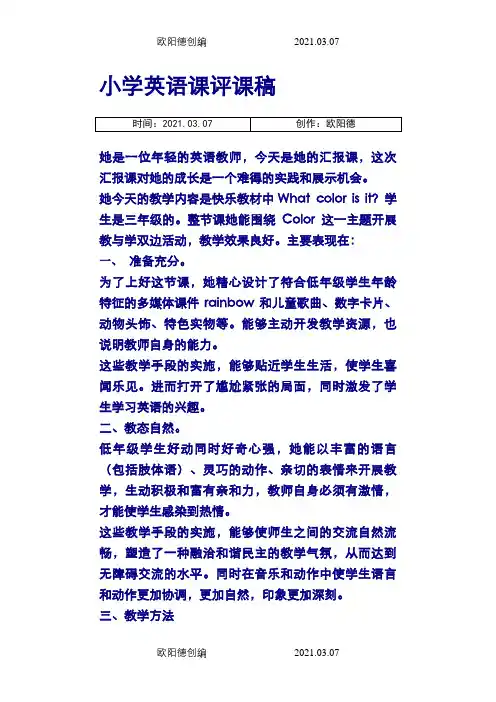
小学英语课评课稿她是一位年轻的英语教师,今天是她的汇报课,这次汇报课对她的成长是一个难得的实践和展示机会。
她今天的教学内容是快乐教材中What color is it?学生是三年级的。
整节课她能围绕Color这一主题开展教与学双边活动,教学效果良好。
主要表现在:一、准备充分。
为了上好这节课,她精心设计了符合低年级学生年龄特征的多媒体课件rainbow和儿童歌曲、数字卡片、动物头饰、特色实物等。
能够主动开发教学资源,也说明教师自身的能力。
这些教学手段的实施,能够贴近学生生活,使学生喜闻乐见。
进而打开了尴尬紧张的局面,同时激发了学生学习英语的兴趣。
二、教态自然。
低年级学生好动同时好奇心强,她能以丰富的语言(包括肢体语)、灵巧的动作、亲切的表情来开展教学,生动积极和富有亲和力,教师自身必须有激情,才能使学生感染到热情。
这些教学手段的实施,能够使师生之间的交流自然流畅,塑造了一种融洽和谐民主的教学气氛,从而达到无障碍交流的水平。
同时在音乐和动作中使学生语言和动作更加协调,更加自然,印象更加深刻。
三、教学方法1、任务型教学:就是在用中学,学中用,学以致用的一种交际英语教学模式。
这种教学能够使情景和英语能够有机结合,体现语言的工具性和人文性。
张老师能够抓住任务型教学的核心,learning by doing。
本节课不再是传统的书本英语和哑巴英语,而是以听说领先,口语突破的方式来实现综合语言运用能力这一英语教学总目标。
2、合作学习法就是新课标提出的一种互动交流和协作式的学习方法,这节课张楠老师能有计划、有目的、有针对性地组织学习学生进行。
使师生之间的交流不再是个人对个人的单独交际,而是变成了教师个人对学生小组集体的控制和管理,简化了师生互动的程序,从而实现了教学效率的提升。
合作学习:避免了以前的单独提问的挂一漏万效果,使学生被小组包围,在小组集体中得到锻炼和发挥,同时避免了个体回答的紧张,同时通过合作走向小组之间的竞争,使学生为小组的荣誉而全力以赴的投入,使学生的积极性也得到大幅度的提高。
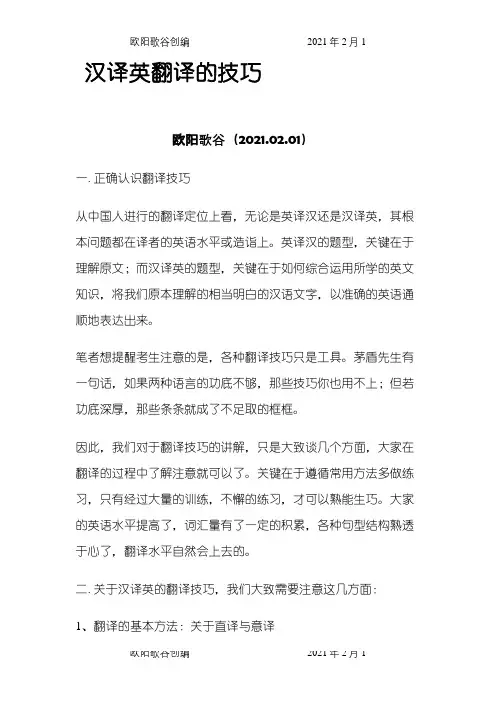
汉译英翻译的技巧欧阳歌谷(2021.02.01)一. 正确认识翻译技巧从中国人进行的翻译定位上看,无论是英译汉还是汉译英,其根本问题都在译者的英语水平或造诣上。
英译汉的题型,关键在于理解原文;而汉译英的题型,关键在于如何综合运用所学的英文知识,将我们原本理解的相当明白的汉语文字,以准确的英语通顺地表达出来。
笔者想提醒考生注意的是,各种翻译技巧只是工具。
茅盾先生有一句话,如果两种语言的功底不够,那些技巧你也用不上;但若功底深厚,那些条条就成了不足取的框框。
因此,我们对于翻译技巧的讲解,只是大致谈几个方面,大家在翻译的过程中了解注意就可以了。
关键在于遵循常用方法多做练习,只有经过大量的训练,不懈的练习,才可以熟能生巧。
大家的英语水平提高了,词汇量有了一定的积累,各种句型结构熟透于心了,翻译水平自然会上去的。
二. 关于汉译英的翻译技巧,我们大致需要注意这几方面:1、翻译的基本方法:关于直译与意译英语和汉语是两种不同的语言 ,每种语言都有各自独立和分明的系统 ,在形态和句法方面二者存在很大差异。
然而 ,两种语言之间又存在一些相似性。
比如在主谓词序和动宾词序上是一致的。
正是由于英汉两种语言既有共同点又有不同点 ,所以在翻译实践中 ,我们不能千篇一律地使用一种方法进行翻译。
直译和意译是两种重要的翻译方法。
直译是既保持原文内容、又保持原文形式的翻译方法或翻译文字。
意译,也称为自由翻译 ,它是只保持原文内容、不保持原文形式的翻译方法或翻译文字。
直译与意译相互关联、互为补充,同时,它们又互相协调、互相渗透,不可分割。
通过对直译与意译二者关系的正确理解,我们可以更多地认识到什么时候采用直译、什么时候采用意译,以及在运用直译与意译的时候所应该掌握的技巧、遵循的原则和应该注意的问题,最终达到提高翻译能力及水平的目的。
考生这里应当注意,直译不是死译,而是指基本保留原有句子结构,照字面意思翻译。
例如:我们的朋友遍天下。
如果译成“Our friends are all over the world”是直译,而“We have friends all over the world”就是意译。
Pride and Prejudice欧阳歌谷(2021.02.01)Many people simply regard Pride and Prejudice as a love story, but in my opinion, this book is an illustration of the society at that time. She perfectly reflected the relation between money and marriage at her time and gave the people in her works vivid characters. The characters have their own personalities. Mrs. Bennet is a woman who makes great efforts to marry off her daughters. Mr. Bingley is a friendly young man, but his friend, Mr. Darcy, is a very proud man who seems to always feel superior. Even the five daughters in Bennet family are very different. Jane is simple, innocent and never speaks evil of others. Elizabeth is a clever girl who always has her own opinion. Mary likes reading classic books. (Actually she is a pedant.) Kitty doesn’t have her own opinion but likes to follow her sister, Lydia. Lydia is a girl who follows exotic things, handsome man, and is somehow a little profligate. When I read the book, I can always find the same personalities in the society now. That is why I think this book is indeed the representative of the society in Britain in the 18th century. The family of gentleman in the countryside is Jane Austen’s favourite topic. But this little topic can reflect big problems. It concludes the stratum situation and economic relationships in Britain in her century. You can find these from the very beginning of this book.The first sentence in this book is impressive. It reads: “It is a truth well known to all the world that an unmarried man in possession of a large fortune must be in need of a wife”. The undertone is very clear: the foundation of the marriage at that time is not emotion but possession.People always think that Austen was an expert at telling love stories. In fact, the marriage in her book is not the result of love, but the result of economic needs. After reading this book, I know the truth is that a poor woman must be in need of a husband, a wealthy man.I couldn’t forget how eager Mrs. Bennet wants to marry o ff her daughters. If you want to know why she is so crazy about these things, I must mention the situation in Britain at that time. Only the eldest son had the privilege of inheriting his father’s possessions. Younger sons and daughters who are used to luxurious lives have no choice but marry a man or woman in possession of a large fortune to continue their comfortable lives. Thus, we can see that getting married is a way to become wealthier, particularly for women without many possessions. Jane Austen told us that money and possession determined everything, including marriage and love in her century.In “Pride and Prejudice”, the sister of Mr. Bingley strongly opposed his plan of marrying Jane because the Bennets don’t have many possessions and their social positions are much lower than them. From this, we can see there are a lot of obstacles for a not very rich womanto marry a wealthy husband. The society, the relatives would not allow them to get married.In modern society, although the marriages of economic needs have decreased rapidly, the concept of “money determines everything” is still rooted in some people’s mind. A lot of parents try hard to interfere their children’s marriages. Education background, possessions, jobs remains the main reason that may influence one’s marriage. Marry for money is still a big problem in our society. We can’t help thinking: can money determine everything?Austen left this problem for us to think. The genius of Jane Austen lies in this perfect simplicity, the simplicity that reflects big problems. Although Austen was only 21 when she wrote “Pride and Prejudice”, her sharp observation of social lives makes the style of this book surprisingly mature and lively. The plots in her works are always very natural. The development of the plot is as inevitable as a problem in mathematics. I think the depth of Pride and Prejudice is the reason that makes this book prominent and classic. Today, her book still can be the guide telling us the economic relationships both at her time and in modern time.CamilleI read the Chinese version of “Camille” a few years ago. At that time I was deeply moved by the main character Marguerite Gautier. “Camille” or “The Lady of the Camellias” by Alexandre Dumas, fils,is the story of Marguerite Gautier, a young courtesan, or kept woman, in Paris in the mid 1800's, and how she falls in love with a young man, Armand Duval, and then tries to escape from her questionable past. Unfortunately, it comes back to haunt her and she ends up returning to that life and dies painfully and alone, but with the knowledge that she was a noble woman at heart. When I first began to read the book, I did not care for Marguerite or her attitude or lifestyle, but as I got further into the narrative, I realized that her saucy attitude was a front to cover the lonely woman that she really was. She felt used, abused and unloved, until the gentle Armand Duval came into her life and showed her that he loved her as a person and not for what she could do for him. It must have taken great courage for Marguerite to leave the life she had lived for so long, knowing all along that it was probably too good to be true and would not last indefinitely. And it also showed that Marguerite really loved Armand Duval for she could even change herself for him.However, happiness didn’t last for long. When M. Duval, Armand's father, came to her, pleading for her to leave Armand to save both Armand's reputation and that of his younger innocent sister, Marguerite saw a way to become pure of heart, if not in body. She felt that it was her duty, because she loved Armand so much, to do this even though it meant giving up her own happiness and hurting Armand temporarily. She reluctantly returned to her former life, knowingthat.diyifanwen some day Armand would forgive her. Sadly, she died in debt and basically alone, except for her one female friend, Julie Duprat, who helped her during her illness. She had her journal sent to Armand after her death, explaining why she had made the choices she had. I think Dumas's last few lines about Marguerite being the exception, not the rule were quite true, and I also agreed with his view that while her lifestyle could not be condoned, we as a society assume that all of these type of women are cold and heartless, while this may not always be the case. A person can make the wrong choices in life when they are young, and try to redeem themselves, but sometimes past situations prevent them from changing their lives, even though they desperately wish to do so. This applies to both men and women in many different types of circumstances: involvement in crime; drug or alcohol abuse; gambling; prostitution; financial problems; poor marriage choices; etc. And this is the fact, which exists in the whole society.As far as the other characters in the book, I think Marguerite was right in saying that no one truly cared about her, but only wanted something from her, the only exceptions being Armand and Julie Duprat. Of course, the Comte de G. and Comte de N. wanted her body and appearance. The Duke needed to “wake up and smell the coffee” and realize that she could never replace his dead daughter. If he truly cared, he could have helped her leave her lifestyle without “keeping”her himself. And lastly, Prudence was a blood-sucking leech who used Marguerite almost worse than the men. I also think she was jealous of the fact that Marguerite had so much more courage than herself and someone truly loved her.Last morning, when tiding my bookshelf, I took this book out of the shelf, and a dried flower flew away from the book. It was pale blue, very transparent, with thin fine veins. a dried flower flew away from the book. It was pale blue, very transparent, with thin fine veins. I held it against the morning light and blew on it. The soft breeze carried it away. Camille is just like the camellia, she could never escape from the destiny of withering. But it wasn’t her fault; it’s because of the evil of Capitalism and the hideousness of that society. Suddenly, I remembere d a saying: “Women are like the flowers”. Those pretty women are like those beautiful flowers; their delicate beauty makes people feel they are the miracle of life. However, even the God envies their beauty. It seems that beautiful women always have tragic endings. As we are normal persons, even we can see the hideousness of humanity that results in their fate of withering, we can at most ask quietly in our hearts: Where have those beautiful flowers gone? Where have they gone?The Life And Adventures Of Robinson CrusoeIt seemed to be such a coincidence that the night after I finished reading The Life And Adventures Of Robinson Crusoe, I was to dinein a restaurant distinctly related to the book itself. This restaurant was no other than the famous American-styled “Friday’s.” The reason for mentioning this restaurant is quite straightforward to all the gentlemen, ladies and children who have read the novel and enjoyed it, which is the fact that this restaurant was, most likely, named after the American Native in Robinson Crusoe, called Friday. This restaurant offers very exceptional service, for instance when the waitresses are asked to order dishes they kneel rather than stand, which, unlike the other restaurants I have been to, makes it easier for the customers to hear them speak. Moreover, Friday’s friendly services to the customers help them to make better choices when ordering dishes. I remembered when I went to Friday’s last time; the waitress kindly described the items on the menu with precise details. It turned out that the combo I initially wanted was designed to be shared among a large group, not to be eaten by one person. I think this restaurant shows many commendable features similar to that of Friday. Friday brought emotional warmth to the people around him with his appealing personality. I think it was this personality that affected Crusoe and made him say that he loved Friday when Crusoe didn’t express love for his parents, brothers, sisters, or even his wife. “When he espied me, he came running to me, laying himself down again upon the ground, with all the possible signs of an humble, thankful disposition, making many antic gestures to show it…to let me know how he wouldserve me as long as he lived.” This was what Friday did after Crusoe had rescued him from the two savages chasing him. It was easy for me to see why Crusoe had loved Friday. After sometime, Crusoe and Friday were to rescue Friday’s father. When Friday reunited with his father, the scene was easy to move anyone: “It would have moved anyone to tears to have seen how Friday kissed him, embraced him, hugged him, cried, laughed, halloed, jumped about, danced, sung; and then sung and jumped about again, like a distracted creature. It was a good while before I could make him speak to me.”This is my favourite chapter in the whole book. It is hard to see why Friday is an ex-savage when he can have personalities more praiseworthy than many civilized people, viz. Crusoe himself. “When he (Friday) went to him (Friday’s father), he would sit down by him, open his breast, and hold his father’s head close to his bosom, half an hour together, to nourish it; then he took his arms and ankles, which were numbed and stiff with the binding, and rubbed them with his hands.”Furthermore, Friday’s expression of loyalty in asking Crusoe to kill him rather than leave him is more heartfelt than anything Crusoe ever says or does.Crusoe, on the absolute contrary, seems incapable of deep feelings, as shown by his account of leaving his family—he never shows any emotions. After a moving lecture from Robinson’s father about his future, he still decided to follow his own wandering ambition. Carelesswas he about the wishes of his parents to keep him alive and prosperous, as he was the only child left in the family. When he came back from the island which he had lived on for twenty eight years, he found that it had been too late to tell his parents that he was still alive, but yet again he did not feel sorry for them; he also did not feel sorry for the two people who had to live in misery for nearly thirty years under the allusion all of their sons were dead. He had the same feelings for his wife: when he was married, he said it was “not either to my disadvantage or dissatisfaction”, implying that it was also neither to his advantage nor his satisfaction. Moreover, after his wife died, Robinson did not think of looking after the three children they had, but went back to the island, which he had lived on for twenty-eight years. It was on this trip which Robinson Crusoe revisited “His Island” as he called it. I feel that Robinson’s indifference to his family is almost emotionally cruel.Before had clearly shown the contrast between Crusoe’s and Friday’s personalities, as when Friday, in his joyful reunion with his father, displayed far more emotion toward his family members than Crusoe, whereas Crusoe never mentions missing his family or dreams about the happiness of seeing them again. I think Defore is very successful in introducing Friday as part of the novel, it makes the whole novel seem much more complete and gripping to the reader, as well as proving that Defoe’s ideology of racism is civilized unlikemany other Europeans at that time; natives and savages are not worse than others but can perhaps even be more modern and civilized. Those are the reasons of why I like The Life And Adventures Of Robinson Crusoe and Friday.Jane EyerThis is a story about a special and unreserved woman who has been exposed to a hostile environment but continuously and fearlessly struggling for her ideal life. The story can be interpreted as a symbol of the independent spirit.It seems to me that many readers’ English reading experience starts with Jane Eyer. I am of no exception. As we refer to the movie “Jane Eyer”, it is not surprising to find some differences because of its being filmized and retold in a new way, but the spirit of the novel remains----to be an independent person, both physically and mentally. Jane Eyer was a born resister, whose parents went off when she was very young, and her aunt,the only relative she had,treated her as badly as a ragtag. Since Jane’s education in Lowwood Orphanage began, she didn’t get what she had been expecting——simply being regarded as a common person, just the same as any other girl around. The suffers from being humiliated and devastated teach Jane to be persevering and prize dignity over anything else.As a reward of revolting the ruthless oppression, Jane got a chance to be a tutor in Thornfield Garden. There she made the acquaintance of lovely Adeleand that garden’s owner, Rochester, a man with warm heart despite a cold face outside. Jane expected to change the life from then on, but fate had decided otherwise: After Jane and Rochester fell in love with each other and got down to get marry, she unfortunately came to know in fact Rochester had got a legal wife, who seemed to be the shadow following Rochester and led to his moodiness all the time ----Rochester was also a despairing person in need of salvation. Jane did want to give him a hand, however, she made up her mind to leave, because she didn’t want to betray her own principles, because she was Jane Eyer. The film has finally got a symbolist end: Jane inherited a large number of legacies and finally returned. After finding Rochester’s misfortune brought by his original mad wife, Jane chose to stay with him forever.I don’t know what others feel, but frankly speaking, I would rather regard the section that Jane began her teaching job in Thornfield as the film’s end----especially when I heard Jane’s words “Never in my life have I been awaken so happily.”For one thing, this ideal and brand-new beginning of life was what Jane had been imagining for long as a suffering person; for another, this should be what the audiences with my views hoped her to get. But the professional judgment of producing films reminded me to wait for a totally different result: There must be something wrong coming with the excellence----perhaps not only should another section be added toenrich the story, but also we may see from the next transition of Jane’s life that “Life is like a box of chocolates, you never know what you would get.”What’s more, this film didn’t end when Jane left Thornfield. For Jane Eyer herself, there should always be somewhere to realize her great ideal of being independent considering her fortitude, but for Rochester, how he can get salvation? The film gives the answer tentatively: Jane eventually got back to Rochester. In fact, when Jane met Rochester for the first time, she scared his horse and made his heel strained, to a certain extent, which meant Rochester would get retrieval because of Jane. We can consider Rochester’s experiences as that of religion meaning. The fire by his frantic wife was the punishment for the cynicism early in his life. After it, Rochester got the mercy of the God and the love of the woman whom he loved. Here we can say: human nature and divinity get united perfectly in order to let such a story accord with the requirements of both two sides. The value of this film may be due to its efforts to explore a new way for the development of humanism under the faith of religion.。
宋老师执教的这一堂课是一堂清晰实在,扎实系统,动静结合的英语课。
教师以新的课程理念为指导,充分考虑学生的年龄特点,在本课的教学设计和组织上注重了以下几个方面。
欧阳歌谷(2021.02.01)1,英文歌曲和游戏导入,充分调动起学生兴趣。
良好的开端对一堂课的成功与否,起着关键的作用。
本堂课一开始,教师就用TPR活动导入新课,使学生的注意力在最短的时间里,被激活。
接着教师利用游戏引出新词教学,自然有效。
2,关注教学方法,体现了一个活字。
教师的教学方法灵活,新单词呈现形式多样。
应该说整堂课中,教师在引入新词时,都是比较新颖而又自然,而且具有生活化的。
教师还注意利用生动的课件,图片,卡片,身体语言,表情动作等作为教学资源,创设讲解,操练和运用英语的情景。
宋老师能贯彻以学生为中心的原则,关注教学过程,尽可能发挥学生的主体作用,让学生真实的去感受知识,体验知识,积极参与,努力实践,在活动中学会用语言表达交流,较好的体现了从不懂到懂,从不会到会,从不熟练到熟练的过程。
3,教学活动的设计丰富多彩,有效,训练方式多样,有全班活动,师生互动,小组活动,双人活动,个人活动等,在活动中突破难点,在活动中发展能力。
教师为了巩固本课的内容,精心设计了多个活动:有歌曲,歌谣,游戏,内容非常丰富不但使单词,句型的操练面广,练习次数多,而且还调动了每一个学生的参与热情。
将热闹的形式与有效的语言实践有机结合。
在英语课中,活动的设计和开展还应该有利于学生学习英语知识,发展语言技能,从而提高学生的综合运用语言的能力。
英语课堂的活动应该以语言运用为落脚点,本堂课上,宋老师很好的贯彻了:在用中学,学中用,学用结合,学以致用的原则。
在这样的一个学习过程中,学习者处于相对自然的态势,不断地在习得和使用语言,学和用每分每秒都和谐的交织在一起。
以上只是我对宋老师这节课的点滴感受,望大家更多地提出自己的见解跟我一起分享!<< Look at the monky>>评课———金丹十一号早晨,市教育局徐局长,市教科院李院长,秦院长冒雨赶赴沔州小学观摩了小学英语优质科大赛。
欧阳歌谷创编 2021年2月1外研社小学英语六年级上册(三年级起点)单词表(带音标)欧阳歌谷(2021.02.01)more than[mɔ: ðæn] 超过thousand['θauzənd]一千kilometre['kiləmi:tə]千米,公里something[ˈsʌmθiŋ]某事物,某种东西*million['miljən]百万map[mæp]地图right[rait]正确的country[ˈkʌntri]国家dancing['dænsiŋ] 跳舞,舞蹈*Chinatown[ˈtʃainəˌtaʊn]唐人街,中国城sometimes[ˈsʌmtaimz]有时shop[ʃɔp]商店then[ðen]既然是这样,那么ah[ɑ:]啊strong[strɔŋ]坚固的collect[kə'lekt]收集stamp[stæmp]邮票hobby[ˈhɔbi]业余爱好*doll [dɔl]玩具娃娃Bicycle[ˈbaisikl]自行车*Thanksgiving['θæŋks,giviŋ]感恩节Thanksgiving Day感恩节flag[flæɡ]旗;国旗Flag Day(美国)国旗制定纪念日fly [flai](使)(旗帜)飘扬special['speʃəl]特殊的,特别的meal[mi:l]餐sound[saund]听起来football [ˈfutbɔ:l](美式)橄榄球moon cake[mu:n keik]月饼the Mid-Autumn Festival中秋节the Dragon Boat Festival端午节race[reis]比赛,竞赛*lantern[ˈlæntən]灯笼the lantern Festival元宵节hang[hæŋ]悬挂,吊pen friend[pen frend]笔友Pleased to meet you!很高兴见到你!address[əˈdres]地址French[frentʃ] 法语age[eidʒ]年龄story[ˈstɔ:ri]故事candy[ˈkændi]糖果World[wɜ:(r)ld]世界often[ˈɔfən]经常difficult[ˈdifikəlt]困难的knife[naif]餐刀;刀子fork[fɔ:k]餐刀;叉chopsticks ['tʃɔpstiks](常复)筷子Japanese[ˌdʒæpə'ni:z]日本的believe[bi'li:v] 相信snake[sneik]蛇*DVD数字化视频光盘,DVD 光盘together[tə'geðə]一起,共同lucky['lʌki] 幸运的bamboo[bæm'bu:]竹子its[its]它的body['bɒdi]身体come out of从……中出来*flute[flu:t]笛子get[get]变得,变成frightened['fraitnd]恐惧的,害怕的long ago很久以前I’d love to我很乐意not really不全是,事实上没有stop(使)停止clean[kli:n]打扫,(使)清洁camera['kæm(ə)rə]照相机show[ʃəʊ] 把……给(某人)看never['nevə]从不around[ə'raʊnd] 在四周,到处all around到处,遍及member state成员国inside[in'said]向室内,向里面should[ʃʊd]应该line [lain] (等候的)长队,队列stand in line排队close[kləʊs]关门,关闭librarian[lai'breəriən]图书馆管理员rule[ru:l]规定,规章quiet['kwaiət]安静的problem['prɔbləm] 麻烦,困难,问题No problem没问题cross[krɔs] 穿过(马路等);渡过(河)。
Tennis 网球 Athletics 竞技 Swimming 游泳 Individual Sports 体育项目 Football 足球 Games and Competitions 球类运动 Baseball & Softball 棒球和垒球 Water Sports 水上运动 Wrestling 搏击类竞技 Bicycles and Motorcycles 自行车和摩托 Basketball 篮球 Riding and Horse Races 赛马 Boxing 拳击 manager 经纪人 instructor 教练,技术指导 guide 领队 trainer 助理教练 referee, umpire (网球.棒球)裁判 linesman,touch judge (橄榄球)裁判 contestant, competitor, player 运动员 professional 职业运动员 amateur 业余运动员,爱好者 enthusiast, fan 迷,爱好者 favourite 可望取胜者(美作:favorite) outsi der 无取胜希望者 championship 冠军赛,锦标赛 champion 冠军 record 纪录 record holder 纪录创造者 ace 网球赛中的一分 Olympic Games, Olympics 奥林匹克运动会 Winter Olympics 冬季奥林匹克运动会 stadium 运动场 track 跑道 ring 圈 ground, field 场地 pitch (足球、橄榄球)场地 court 网球场 team, side 队竞技性运动competitive sport 用粉笔记下(分数等);达到,得到chalk up 出名make one's mark 体育项目(尤指重要比赛)event 体育PE (Physical Education) 体格、体质physique 培训groom 余的,带零头的odd 年少者junior 残疾人the handicapped/disa bled 学龄前儿童preschool 全体;普通;一般at large 平均寿命life expectancy 复兴revitalize 使有系统;整理systemize 历史悠久的time-honored 跳板spring-board 秋千swing 石弓,弩crossbow (比赛等的)观众spectator 取得进展make headway 体育大国/强国sporting/sports power 与...有关系,加入be affiliatedto/with 落后lag behind 武术martial arts 五禽戏five-animal exercises 体育运动physical culture and sports 增强体质to strengthen one's physique 可喜的,令人满意的gratifying 称号,绰号label 涌现出来to come to the fore 源源不断 a steady flow of 队伍contingent 又红又专/思想好,业务精to be both socialist-minded and vocationally proficient 体育界sports circle(s) 承担义务to undertake obligation 黑马dark horse 冷门an unexpected winner; dark horse 爆冷门to produce an unexpected winner 发展体育运动,增强人民体质Promote physical culture and build up the people'shealth 锻炼身体,保卫祖国Build up a good physique to defend the country 为祖国争光to winhonors for the motherland 胜不骄,败不馁 Do not become cocky/be dizzy with success, nor downcastover/discouraged by defeat. 体育道德sportsmanship 打出水平,打出风格up to one's best level in skill and style of play 竞技状态好in good form 失常to lose one's usual form 比分领先to outscore 打成平局to draw/to tie/to play even/to level the score 失利to lose 中华人民共和国运动委员会(国家体委) Physical Culture and Sports Commission of the PRC (State Physical Culture and Sports Commission) 中华全国体育总会All-China Sports Federation 国际奥林匹克委员会International Olympic Committee 少年业余体育学校youth spare-time sports school, youth amateur athletic school 辅导站coaching center 体育中心sportscenter/complex 竞赛信息中心competition information center 运动会sports meet; athletic meeting; games 全国运动会NationalGames 世界大学生运动会World University Games; Universiade 比赛地点competition/sport s venue(s) 国际比赛international tournament 邀请赛invitational/invita tional tournament 锦标赛championship 东道国host country/nation 体育场stadium; sportsfield/ground 体育馆gymnasium, gym; indoor stadium 比赛场馆competition gymnasiums and stadiums 练习场馆training gymnasiums 操场playground; sports ground; drill ground 体育活动sports/sporting activities 体育锻炼physical training 体育锻炼标准standard for physical training 体育疗法physical exercise therapy; sports therapy 广播操setting-up exercises to music 课/工间操physical exercises during breaks 体育工作者physical culture workers, sports organizer 运动爱好者sportsfan/enthusiast 观众 spectator 啦啦队cheering-section 啦啦队长cheer-leader 国家队national team 种子队seeded team 主队 home team 客队visiting team 教练员coach 裁判员referee,umpire 裁判长chief referee 团体项目team event 单项individualevent 男子项目men's event 女子项目women's event 冠军champion; gold medalist 全能冠军all-round champion 亚军running-up; second; silver medalist 第三名third; bronze medalist 世界纪录保持者world-record holder 运动员athlete; sportsman 种子选手seeded player; seed 优秀选手top-ranking/topnotch athlete 田径运动track and field; athletics 田赛field events 竞赛track events 跳高high jump 撑杆跳高pole jump; polevault 跳远long/broadjump 三级跳远hop, step and jump; triple jump 标枪javelin throw 铅球shot put 铁饼discus throw 链球hammer throw 马拉松赛跑Marathon (race) 接力relay race; relay 跨栏比赛hurdles; hurdle race 竞走walking; walking race 体操gymnastics 自由体操floor/free exercises 技巧运动acrobatic gymnastics 垫上运动mat exercises 单杠horizontal bar 双杠parallel bars 高低杠uneven bars; high-low bars 吊环rings 跳马vaulting horse 鞍马pommel horse 平衡木balance beam 球类运动ball games 足球football;soccer 足球场field; pitch 篮球basketball 篮球场basketball court 排球volleyball 乒乓球table tennis; ping pong 乒乓球拍racket; bat 羽毛球运动badminton 羽毛球shuttlecock; shuttle 球拍racket 网球tennis 棒球baseball 垒球softball 棒/垒球场baseball(soft ball)field/ground 手球handball 手球场handball field 曲棍球hockey; field hockey 冰上运动ice sports 冰球运动ice hockey 冰球场rink 冰球puck; rubber 速度滑冰speed skating 花样滑冰figure skating 冰场skating rink; icerink 人工冰场artificial ice stadium 滑雪skiing 速度滑雪cross country ski racing 高山滑雪alpine skiing 水上运动water/acquatic sports 水上运动中心aquatic sports center 水球(运动)water polo 水球场playing pool 滑水water-skiing 冲浪surfing 游泳swimming 游泳池swimming pool 游泳馆natatorium 自由泳freestyle; crawl (stroke) 蛙泳breaststroke 侧泳sidestroke 蝶泳butterfly (stroke) 海豚式dolphinstroke/kick 蹼泳fin swimming 跳水 diving 跳台跳水platformdiving 跳板跳水springboard diving 赛艇运动rowing 滑艇/皮艇 canoeing 帆船运动yachting; sailing 赛龙船dragon-boat racing 室内运动indoor sports 举重weightlifting 重量级heavyweight 中量级middleweight 轻量级lightweight 拳击boxing 摔交wresting 击剑fencing 射击shooting 靶场shootingrange 射箭archery 拳术quanshu; barehanded exercise; Chinese boxing 气功qigong; breathing exercises 自行车运动cycling; cycle racing 赛车场(自行车等的)倾斜赛车场cycling track 室内自行车赛场indoor velodrome 摩托运动motorcycling 登山运动mountaineering; mountain-climbing 骑术horsemanship 赛马场equestrian park 国际象棋(international) chess 特级大师grandmaster 象棋xiangqi; Chinesechess race跑 middle-distance race 中长跑 long-distance runner 长跑运动员 sprint 短跑(美作:dash) the 400 metre hurdles 400米栏 marathon 马拉松 decathlon 十项 cross-country race 越野跑 jump 跳跃 jumping 跳跃运动 high jump 跳高 long jump 跳远(美作:broad jump) triple jump, hop step and jump 三级跳 pole vault 撑竿跳 throw 投掷 throwing 投掷运动 putting the shot, shot put 推铅球 throwing the discus 掷铁饼 throwing the hammer 掷链锤 throwing the javelin 掷标枪 walk 竞走 3.Individual Sports 体育项目 gymnastics 体操 gymnastic apparatus 体操器械 horizontal bar 单杠 parallelbars 双杠 rings 吊环 trapeze 秋千 wall bars 肋木 side horse, pommelled horse 鞍马 weight-lifting 举重 weights 重量级 boxing 拳击 Greece-Roman wrestling 古典式摔跤 hold, lock 揪钮 judo 柔道 fencing 击剑 winter sports 冬季运动 skiing 滑雪 ski 滑雪板 downhill race 速降滑雪赛,滑降 slalom 障碍滑雪 ski jumping competition 跳高滑雪比赛 ski jump 跳高滑雪 ice skating 滑冰 figure skating 花样滑冰 roller skating 滑旱冰 bobsleigh, bobsled 雪橇 4.Games andCompetitions 球类运动 football 足球 rugby 橄榄球 basketball 篮球 volleyball 排球 tennis 网球 baseball 垒球 handball 手球 hockey 曲棍球 golf 高尔夫球 cricket 板球 ice hockey 冰球 goalkeeper 球门员 centre kick 中线发球 goal kick 球门发球 throw in, line-out 边线发球 to score a goal 射门得分 to convert a try 对方球门线后触地得分 batsman 板球运动员 batter 击球运动员 men's singles 单打运动员 in the mixed doubles 混合双打 5.Water Sports 水上运动 swimming pool 游泳池 swimming 游泳 medley relay 混合泳 crawl 爬泳 breaststroke 蛙式 backstroke 仰式 freestyle 自由式 butterfly (stroke) 蝶泳 diving competition 跳水 water polo 水球 water skiing 水橇 rowing 划船 canoe 划艇 boat race 赛艇 yacht 游艇 kayak 皮船 sailing 帆船运动 outboard boat 船外马达 6.Bicycles and Motorcycles 自行车和摩托车 car 车类运动 velodrome, cycling stadium 自行车赛车场 road race 公路赛 race 计时赛 chase 追逐赛 motorcycle, motorbike 摩托车 racing car 赛车 racing driver 赛车驾驶员 rally 汽车拉力赛 7.Riding and Horse Races 赛马 riding 骑马 racecourse, racetrack 跑马场,赛马场 jockey, polo 马球 rider 马球运动员 show jumping competition 跳跃赛 steeplechase 障碍赛 fence 障碍 trotter 快跑的马 8.Tennis 网球 tennis 网球运动 lawn tennis 草地网球运动 grass court 草地网球场 racket 球拍 racket press 球拍夹 gut, string (球拍的)弦 line ball触线球 baseline ball 底线球 sideline ball 边线球 straight ball 直线球 down-the-line shot 边线直线球 crosscourt 斜线球 high ball, lob 高球 low ball 低球 long shot 长球 short shot 短球 cut 削球 smash 抽球 jump smash 跃起抽球 spin 旋转球 low drive 抽低球 volley 截击空中球 low volley 低截球 deep ball 深球 heavy ball 重球 net 落网球 flat stroke 平击球 flat drive 平抽球 let 重发球 fluke, set-up, easy 机会球 ground stroke 击触地球 wide打出边线的球 overhead smash, overhand smash 高球扣杀 game 局 set 盘 fifteen all 一平 thirty all 二平 forty all 三平 deuce 局末平分, 盘末平局 love game 一方得零分的一局 double fault 双误, 两次发球失误‘not up’, 两跳,还击前球着地两次 service line 发球线 fore court 前场 back court 后场 centre mark 中点 server 发球员 Swimming 游泳 swimming pool 游泳池 changing room 更衣室 shower 淋浴 diving platform 跳台 ten-meter platform 10米跳台 five-meter platform 5米跳台 three-meter springboard 3米跳板 one-meter springboard 1米跳板 diving pool 跳水池 non-swimmer's pool 浅水池 swimmer's pool 深水池 starting block 出发台 starting dive 出发起跳 rope with cork floats 水线 swimming lane 泳道 touching the finishing line 终点触线 timekeeper 计时员 lifesaver, lifeguard 救生员 land drill 陆上练习 breaststroke蛙泳 crawl stroke 爬泳 back stroke 仰泳 side stroke 侧泳 butterfly stroke 蝶泳 dolphin butterfly stroke 海豚式蝶泳 treading water 踩水 underwater swimming 潜泳 swimming pool with artificial waves 人工海浪泳池 artificial waves 人工海浪 swimming trunks 泳裤 swimsuit, swimming suit 泳衣 swimming cap 泳帽 bikini 比基尼泳衣 bikini top 比基尼乳罩 bikini bottom 比基尼式泳裤 surfing 冲浪 surfboard 冲浪板 water ski滑水橇 10.Football 足球 football, soccer, Association football 足球 field, pitch 足球场 midfield 中场 kick-off circle 中圈 half-way line 中线 football, eleven 足球队 football player 足球运动员 goalkeeper, goaltender, goalie 守门员 back 后卫 left 左后卫 right back 右后卫 centre half back 中卫 half back 前卫 left half back 左前卫 right half back 右前卫 forward 前锋 centre forward, centre 中锋 inside left forward, inside left 左内锋 inside rightforward, inside right 右内锋 outside left forward, outside left 左边锋 outside right forward, outside right 右边锋 kickoff 开球 bicycle kick, overhead kick 倒钩球 chest-high ball 平胸球 corner ball, corner 角球 goal kick 球门球 ground ball, grounder 地面球 hand ball 手触球 header 头球 penalty kick 点球 spot kick 罚点球 free kick 罚任意球 throw-in 掷界外球 ball handling 控制球 block tackle 正面抢截 body check 身体阻挡 bullt 球门前混战 fair charge合理冲撞 chesting 胸部挡球 close-marking defence 钉人防守 close pass, short pass 短传 consecutive passes 连续传球 deceptive movement 假动作 diving header 鱼跃顶球 flying headar 跳起顶球 dribbling 盘球 finger-tip save (守门员)托救球 clean catching (守门员)跳球抓好 flank pass 边线传球 high lobbing pass 高吊传球 scissor pass 交叉传球 volley pass 凌空传球 triangular pass 三角传球 rolling pass, ground pass 滚地传球 slide tackle 铲球 clearance kick解除危险的球 to shoot 射门 grazing shot 贴地射门 close-range shot 近射 long drive 远射 mishit 未射中 offside 越位 to pass the ball 传球 to take a pass 接球 spot pass 球传到位 to trap 脚底停球 to intercept 截球 to break through, to beat 带球过人 to break loose 摆脱 to control the midfield 控制中场 to disorganize the defence 破坏防守 to fall back 退回 to set a wall 筑人墙 to set the pace 掌握进攻节奏 to ward off an assault 击退一次攻势 to break up an attack 破坏一次攻势 ballplaying skill 控球技术 total football 全攻全守足球战术 open football 拉开的足球战术 off-side trap 越位战术 wing play 边锋战术 shoot-on-sight tactics 积极的抢射战术 time wasting tactics 拖延战术 Brazilian formation 巴西阵式,4-2-4 阵式 four backs system 四后卫制 four-three-three formation 4-3-3 阵式 four-two-four formation 4-2-4 阵式 red card 红牌(表示判罚出场) yellow card 黄牌(表示警告) Baseball and Softball 棒球和垒球 baseball棒球 baseball field, baseball ground 棒球场 softball 垒球 softball field, softball ground 垒球场 infield,diamon d 内场 outfield 外场 fair territory 界内地区 foul territory 界外地区 foul line 边线 base line 垒间线 base 垒 bag 垒垫, 垒包 home base 本垒 first base 一垒 second base 二垒 third base 三垒 home plate 本垒板 pitcher's plate 投手板 pitcher's mound (棒球)投手土墩 pitcher's circle (垒球)投手圈 batter's box 击球员区 on deck circle 击球员准备区 catcher's box 接手区 coacher's box 跑垒指导员区 bench, dug-out 队员席 bull-pen 候补投手练习区 glove 手套, 分指手套 milt 合指手套 bat 球棒 mask 护面 chest protector 护胸 leg protector 护腿 supporter 护裆 helmet 护帽 baseball player 棒球运动员 softball player 垒球运动员 pitcher 投手 catcher 接手 fielder 守场员 baseman 守垒员 infielder 内场手 first baseman 一垒手 second baseman 二垒手 third baseman 三垒手 shortstop游击手 outfielder 外场手 batter, hitter 击球员 base-runner 跑垒员 batter-runner 击跑员 relief pitcher 候援投手 designated hitter (DH) 指名击球员 coacher 跑垒指导员 manager 总教练 plate umpire 司球裁判员 base umpire 司垒裁判员 inning 局次 visiting team 先攻队 home team 后攻队 offensive team 攻队 defensive team 守队 pitching 投手投球 windup position (棒球投手)正面投球法 set up position(棒球投手)侧身投球法 sling shot (垒球投手)后摆投球法 wind mill (垒球投手)绕环投球法 8 figure (垒球投手)8字投球法 throwing 传球 catching 接球 fielding 防守 batting, hitting 击球 base running 跑垒 stealing 偷垒 sliding 滑垒 strike zone 好球区 fair ball 界内球 foul ball 界外球 illegal pitch 不合法投球 illegally batted ball 不合法击球 bunt 触击球 foul tip 擦棒球 bunting 触击 swing 挥击 ground ball, grounder 地滚球 liner, line drive 平直球 fly ball 腾空球 hit, safety hit 安全打 one base hit 一垒打 two base hit 二垒打 three base hit 三垒打 home run, homer 本垒打 sacrifice hit 牺牲打 sacrifice bunt 牺牲触击 sacrifice fly 牺牲腾空球 squeeze bunt 抢分触击 run and hit, hit and run 击跑配合战术 safe 安全上垒 base on balls 四球安全上垒 struck-out 三击出局 run,score 得分 batting order 击球次序 wild pitch (投手)暴投 pick-off (投手)牵制跑垒员的传球 balk (棒球)投手犯规 put-out 接杀 out, down, away 出局 touch out 触杀 force out 封杀 assist 助杀 run down 夹杀 double play, double kill 双杀 triple play, triple kill 三杀 wild throw 野传球 passed ball 接手漏接球 ball in play, live ball 继续比赛, 活球 ball not in play, dead ball 死球 cover 补位 back up 策应 cut-off 拦接 play shallow 近迫防守 play deep 后撤防守 appeal play 申诉行为 called game 有效比赛 forfeited game 比赛弃权 battingaverage 安打率 fielding average 防守率 earned run 投手责任失分 complete game 无安打无得分获胜的比赛 Wrestling 搏击类竞技 Greek-Roman wrestling 古典式摔跤 wrestler 摔跤运动员 standing wrestling 站立摔 on-the-ground wrestling 跪撑摔 bridge 角力桥 free style wrestling 自由式摔跤 bar arm with grapevine 锁臂缠腿 double leg lock 抱单腿拦腿摔 13. Boxing 拳击 boxer 拳击运动员 boxing glove 拳击手套 boxing shoe拳击鞋 infighting 近战 straight punch 直拳 uppercut 上钩拳 right hook 右钩拳 foul 犯规 punch bag 沙袋 punch ball 沙球 boxing match 拳击比赛 referee 裁判员 boxing ring 拳击台 rope 围绳 winner 胜利者 loser by a knockout 被击败出局者 timekeeper 计时员 boxing weights 拳击体重级别 light flyweight 48公斤级, 次特轻量级 flyweight 51公斤级, 特轻量级 bantamweight 54公斤级, 最轻量级 featherweight 57公斤级, 次轻量级 lightweight60公斤级, 轻量级 light welterweight 63.5公斤级, 轻中量级 welterweight 67公斤级, 次中量级 light middleweight 71公斤级, 中量级 middleweight 75公斤级, 次重量级 light heavyweight 81公斤级, 重量级 heavyweight 81以上公斤级, 最重量级 14 Basketball 篮球英语球场-court 前锋-forwards 后卫-guards 中锋-center 后场-backcourt 前场-frontcourt 得分后卫-point guard 组织后卫-shooting guard 大前锋-powerforward 小前锋-small forward 篮框-rim,basket 争球-jump ball 攻方-offense 守方-defence 计时器-shot clock 打成平分-tie 加时赛-overtime(OT)运球-dribbling 身前快速运球-speed 双手交替运球-crossover 身后运球-behind-the-back 腿间运球-between-the -leg 转身运球-spin 传球-pass 胸部传球-chest 反弹传球-bounce 过顶传球-overhead 大力传球-baseball-type 身后传球-behind-the-back 投篮方式-shooting form 直接篮下得分-layup 大力灌篮-the dunk shot 跳投-jump shot 勾手投篮-hook shot 投篮命中率-field goalds (FGs)三分球命中率-3-point FGs 罚球-foul shot 罚球线-free throw line 篮板-rebound 攻方篮板-off.rebounds 守方篮板-def.rebounds 助攻-assists 内线得分-points in paint 暂停-time -out 卡位-screens 人盯人-men-to-men defense 区域防守-zone defense 盖帽-欧阳歌谷创编 2021年2月1 blocking 失误-turnovers 撞人犯规-charging 阻挡犯规-holding 推人犯规-pushing 技术犯规-technical offence(fouls)常规赛-regularseason 季后赛-playoff欧阳歌谷创编 2021年2月1。
小学英语评课稿范文今天市教科院到我们学校指导工作,听取了两位英语教师的课既有共同点,同时又各有千秋。
一、创设情境,激发兴趣两位教师的导入设计了不同的情境,引起了学生的求知兴趣。
王老师带领学生随着舒缓的音乐踏进了动物乐园,先让学生感受动物的可爱,运用事先准备好的宠物进入新内容的学习。
陈老师先是和学生在自由交谈中与学生交朋友,邀请大家到她家做客,进而导入房间的样子学习房间名称,借助形象的课件向学生展示各个房间的样子,真是恰到好处。
引人入胜的教学情境,使学生很快进入了学习状态。
二、运用多媒体教学,突出重点,突破难点两位教师根据不同的教学目标设计了不同的课件内容,化抽象为具体、直观展示所学知识,让学生在愉悦的氛围中得到新知识的训练,形象而直观地突破了教学难点,突出了英语教学以听、说、读为主的能力培养,使学生能快速地记忆单词,进入情景进行对话练习。
三、结合生活实际,运用所学内容两位教师的课程内容与生活实际紧密相连,达到了英语教学口语化的目的。
从熟悉的小动物、房子的样子,以日常生活用语为主,从生活需要出发,使英语知识生活化,口语化。
拉近了学生与文本的距离,培养了学生说英语的意识,用英语的能力。
除此之外,两位教师还各自有不同的教学风格。
王老师的课1、轻松自如教师教态亲切、自然,英语口语流利,给学生创造了良好说的氛围,使学生能够在轻松愉快的氛围中感受英语语音,体验英语语音。
这一点非常好,值得我学习。
2、教学扎实王老师整堂课的思路非常清晰,活动扎实有效。
在新课教学中围绕几个动物的名称展开扎实有效的训练,以猜谜语游戏、词图搭配游戏、运动会入场式等把课推向了高潮,使学生学的很有劲,也很扎实。
3、活动设计有层次性需要探讨的地方:1、对学生的小组活动需加强指导,所布置的任务不够明确,小组活动合作性不强。
1、整堂课放手给学生的时间少,如果能增加生生对话,小组活动,可以给少数性格内向羞涩的学生提供更多口语练习的机会。
2、课件制作不够精致,猜谜游戏学生看着动物猜失去猜得意义了。
我他她它你他们1.主格人称代词:I,he,she,it,you, they2.宾格人称代词:me,him,she,it,you,them3.名词性物主代词:mine,his,hers,its,yours,theirs4.形容词性物主代词:my,his,her,its,your,their5.单数形式反身代词:myself,himself,herself,itself,yourself6.复数形式反身代词:ourselves,themselves,themselves,themselves,yourselves欧阳歌谷(2021.02.01)主格用作主语,如: I am a girl.宾格用作宾语,在动词或者介词后:动词后:This is me.介词后:Go without me.所有格相当于形容词,后面接名词,如:This is my book.名词形式的所有格=所有格+名词.比如:my book = mine (当然,前面要有提及,要不然你说Mine别人不知道你说的具体是什么东西)如: A: Is this your book?B: Yes, It is mine!(相当于It is my book!)主格人称:i you she he they 作主语时用宾格人称:me you her him them 作宾语使用反身代词:myself yourself herself themself himself强调自己的什么,意思为我自己,他自己。
他们自己物主代词:my her his your their 后可直接跟宾语形容词性物主代词my,his,her,its,your,their等等一般放在名词前面表示修饰物的所属关系因为在名词前所以就相当于形容词因此得名在句子中做定语如:my dog 我的狗my是dog的定语名词性物主代词mine,his,hers,its,yours,theirs等等顾名思义其实就相当于名词一般指代上文提到过的食物或两个或两个以上同类事物的不同所属如hers=her + n-My book is nice.How about yours?-Mine is ugly. 以此句子解释一下后者语言比较难表达= = 就是说同是书但是有两本每人一本在句子中可做主语宾语表语(He is mine.)be动词属于系动词,在一般现在时态的句子中主要表现为三种形式:am is、are。
小学英语评课稿范文欧阳歌谷(2021.02.01)今天市教科院到我们学校指导工作,听取了两位英语教师的课既有共同点,同时又各有千秋。
一、创设情境,激发兴趣两位教师的导入设计了不同的情境,引起了学生的求知兴趣。
王老师带领学生随着舒缓的音乐踏进了动物乐园,先让学生感受动物的可爱,运用事先准备好的宠物进入新内容的学习。
陈老师先是和学生在自由交谈中与学生交朋友,邀请大家到她家做客,进而导入房间的样子学习房间名称,借助形象的课件向学生展示各个房间的样子,真是恰到好处。
引人入胜的教学情境,使学生很快进入了学习状态。
二、运用多媒体教学,突出重点,突破难点两位教师根据不同的教学目标设计了不同的课件内容,化抽象为具体、直观展示所学知识,让学生在愉悦的氛围中得到新知识的训练,形象而直观地突破了教学难点,突出了英语教学以听、说、读为主的能力培养,使学生能快速地记忆单词,进入情景进行对话练习。
三、结合生活实际,运用所学内容两位教师的课程内容与生活实际紧密相连,达到了英语教学口语化的目的。
从熟悉的小动物、房子的样子,以日常生活用语为主,从生活需要出发,使英语知识生活化,口语化。
拉近了学生与文本的距离,培养了学生说英语的意识,用英语的能力。
除此之外,两位教师还各自有不同的教学风格。
王老师的课1、轻松自如教师教态亲切、自然,英语口语流利,给学生创造了良好说的氛围,使学生能够在轻松愉快的氛围中感受英语语音,体验英语语音。
这一点非常好,值得我学习。
2、教学扎实王老师整堂课的思路非常清晰,活动扎实有效。
在新课教学中围绕几个动物的名称展开扎实有效的训练,以猜谜语游戏、词图搭配游戏、运动会入场式等把课推向了高潮,使学生学的很有劲,也很扎实。
3、活动设计有层次性需要探讨的地方:1、对学生的小组活动需加强指导,所布置的任务不够明确,小组活动合作性不强。
1、整堂课放手给学生的时间少,如果能增加生生对话,小组活动,可以给少数性格内向羞涩的学生提供更多口语练习的机会。
2、课件制作不够精致,猜谜游戏学生看着动物猜失去猜得意义了。
陈老师的课思路清晰,环环相扣。
教学目标明确,英语口语流利,备课充分,练习方式多样化。
本节课单词多,知识密度大,陈老师就选用富有创造性的表演,结合学生的实际生活(自己的家)激励学生大胆开口说英语,培养学生自信心,达到了学以致用的目的,培养了语言交际能力,遵循了实用性原则。
一点不成熟的看法:1、课堂教学缺少学生操作性活动,没有面向全体学生。
活动能够促使学生获取知识,主动运用英语交流,发展用英语解决问题的能力,本节课基本上没有小组操练新单词和新句子,教授新课时,一问一答都是以“教师为主,个别学生回答”,关注学生的面不够。
2、教学过程中没有注意到细节,比如:游戏之前没有讲清楚游戏规则致使学生不能很好的完成;“snack”教学时应注意让获得零食的学生说说该生词,体现英语学科说的特点。
3、拓展部分没有充分发挥学生的潜能,是否考虑让学生自己设计理想中的家的样子,然后运用所学加以描述,这样会更好的发挥学生的自主性。
总之,我们的英语教学应体现出学生的主体性,设计多种多样的活动,教学过程中注意细节的处理和发音的准确性,评价机制要公平竞争,照顾到学生的自尊心,确定教学目标时以实际运用为出发点,在学中用,用中学。
篇二:小学英语优秀实用教师评课稿所谓教学方法:包括教师“教”学活动方式,还包括学生在教师指导下“学”的方式,是“教”的方法与“学”的方法的统一。
本堂课,教师在整个清晰的教学过程中采用的教学方法有如下几个特点:(一)优选活用一种好的教学方法总是相对而言的,它总是因课程,因学生,因教师自身特点而相应变化的。
今天的这堂课,对象是二年级的学生,教学内容是can句型与词汇的掌握,教师是充满活力的季教师,因此各种方法的选用就显示出相当的贴切与有效。
开始部分的儿歌sing, sing, sing a song. dance, dance, dance with me. write, write, write a letter? 非常有节奏;展开部分的ask and answer、find partners能够贴近学生;动作表演action,表情模仿imitation,唱歌,观看卡通片watching video,贯穿始终的情景表演(situation)等方法更是有效地促进、巩固了教学。
(二)新颖多样教学活动的复杂性决定了教学方法的多样性。
所以教师必须面向实际,恰当地选择教学方法,同时还要在教学方法多样性上下一番功夫,使课堂教学超凡脱俗,常教常新,富有艺术性。
本堂课该教师安排了多样的学生活动,其中有个人、小组和全班性的,有教师指导性的,如小对话的教学,老师就起到了很好的示范作用。
也有需学生独立或合作完成的。
如:talk about the pictures.活动均有明确的目标与要求,并能够安排在一定的语境和情景中进行,突出了培养学生用英语做事情和用英语进行交流的能力,体现了交际语言教学的思想。
(三)现代化教学手段运用现代化教学呼唤现代化手段。
“一支粉笔一本书,一块黑板一张嘴”的陈旧单一教学手段应该成为历史。
季教师适时、适当地用了录音机、电脑等现代化教学手段。
goofy形象的出现尤其受到学生的欢迎,巧妙的是该段的播放是穿插在学生的思维完全被激活的状态下的,climb的掌握是学生急切需要的,学生是为了更好的拥有语言材料而在观看这个片段,因此,媒体地运用显得相当自然和到位。
三、活跃的气氛中展现良好的教学素质北京首都师范大学外语系张连仲教授曾这样指出:评价一节课成功与否,主要应看学生在活动中的参与程度,学生言语交际的有效性,以及学生在学习中表现出的情感、合作精神和学习与交际策略等方面的发展情况。
今天我们在课堂感受到的,最强烈的就是飞扬在整个课堂上的师生的激情。
季教师夸张到位的肢体语言climb、run、swim、skip学生感受真切;丰富的脸部表情sad、happy、angry强烈地吸引了学生的注意力,口琴的吹奏更是增色不少。
同时,季老师也营造了良好的、平等的课堂氛围:与学生一起skip the rope、play the basketball、climb on the floor,师生互动的课堂是多么快乐的地方;当有一位学生模仿goofy反复不成功时,老师俯下身贴着学生的耳朵耐心地个别辅导,直到清晰地发出这个音为止,这些都让学生感受到了教师的真诚与投入。
其次是良好的语言表达能力,语音纯正、语调自然,口齿清晰,极富感染力,几乎是完美的完成了一个老师应表现的素养。
季延峰老师的这堂课获得了上海市一等奖的好成绩,这给我们宝山的英语教学无疑是极大地鼓舞,衷心期待我们的英语教师队伍中继续涌现如此优秀的青年教师。
一、创设情境,激发兴趣两位教师的导入设计了不同的情境,引起了学生的求知兴趣。
王老师带领学生随着舒缓的音乐踏进了动物乐园,先让学生感受动物的可爱,运用事先准备好的宠物进入新内容的学习。
陈老师先是和学生在自由交谈中与学生交朋友,邀请大家到她家做客,进而导入房间的样子学习房间名称,借助形象的课件向学生展示各个房间的样子,真是恰到好处。
引人入胜的教学情境,使学生很快进入了学习状态。
二、运用多媒体教学,突出重点,突破难点两位教师根据不同的教学目标设计了不同的课件内容,化抽象为具体、直观展示所学知识,让学生在愉悦的氛围中得到新知识的训练,形象而直观地突破了教学难点,突出了英语教学以听、说、读为主的能力培养,使学生能快速地记忆单词,进入情景进行对话练习。
三、结合生活实际,运用所学内容两位教师的课程内容与生活实际紧密相连,达到了英语教学口语化的目的。
从熟悉的小动物、房子的样子,以日常生活用语为主,从生活需要出发,使英语知识生活化,口语化。
拉近了学生与文本的距离,培养了学生说英语的意识,用英语的能力。
除此之外,两位教师还各自有不同的教学风格。
王老师的课1、轻松自如教师教态亲切、自然,英语口语流利,给学生创造了良好说的氛围,使学生能够在轻松愉快的氛围中感受英语语音,体验英语语音。
这一点非常好,值得我学习。
2、教学扎实王老师整堂课的思路非常清晰,活动扎实有效。
在新课教学中围绕几个动物的名称展开扎实有效的训练,以猜谜语游戏、词图搭配游戏、运动会入场式等把课推向了高潮,使学生学的很有劲,也很扎实。
3、活动设计有层次性/forum.php?mod=viewthread&tid=175608)步感知了单词的写法,然后运用手中的单词卡多种形式的对比练习,学生很快掌握了动物名称及单词的认读。
拓展部分运用所学内容自由对话,挖掘学生创造使用语言的能力,从教师的语言输入转为学生的语言输出,符合语言的习得规律。
需要探讨的地方:1、对学生的小组活动需加强指导,所布置的任务不够明确,小组活动合作性不强。
1、整堂课放手给学生的时间少,如果能增加生生对话,小组活动,可以给少数性格内向羞涩的学生提供更多口语练习的机会。
2、课件制作不够精致,猜谜游戏学生看着动物猜失去猜得意义了。
陈老师的课思路清晰,环环相扣。
教学目标明确,英语口语流利,备课充分,练习方式多样化。
本节课单词多,知识密度大,陈老师就选用富有创造性的表演,结合学生的实际生活(自己的家)激励学生大胆开口说英语,培养学生自信心,达到了学以致用的目的,培养了语言交际能力,遵循了实用性原则。
一点不成熟的看法:1、课堂教学缺少学生操作性活动,没有面向全体学生。
活动能够促使学生获取知识,主动运用英语交流,发展用英语解决问题的能力,本节课基本上没有小组操练新单词和新句子,教授新课时,一问一答都是以“教师为主,个别学生回答”,关注学生的面不够。
2、教学过程中没有注意到细节,比如:游戏之前没有讲清楚游戏规则致使学生不能很好的完成;“snack”教学时应注意让获得零食的学生说说该生词,体现英语学科说的特点。
3、拓展部分没有充分发挥学生的潜能,是否考虑让学生自己设计理想中的家的样子,然后运用所学加以描述,这样会更好的发挥学生的自主性。
总之,我们的英语教学应体现出学生的主体性,设计多种多样的活动,教学过程中注意细节的处理和发音的准确性,评价机制要公平竞争,照顾到学生的自尊心,确定教学目标时以实际运用为出发点,在学中用,用中学。
刚才大家看到的是大华二小季延峰老师参加上海市英语教师教学评优的参赛课:oxford english 2b unit 4 《in the park》第二教时let‘s talk.季延峰老师是我区英语教师队伍中相当优秀、相当有活力的青年教师。
本堂课充分展示了他作为一名青年男教师独特的教学风格和充满生机的教学魅力。
今天我想从本堂课的教学目标与设计,教学方法与过程,教学效果与教师素养四个方面进行点评。